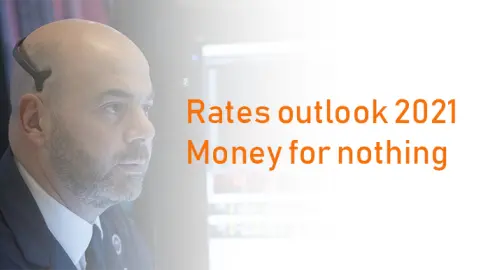EUR money markets: More liquidity, more compression
Money markets will remain under the spell of high excess liquidity levels. This means ever lower Euribor fixings and commercial paper rates. We do not anticipate the ECB will cut its policy rate, but cheaper liquidity injections are on the cards
A still rising tide of excess liquidity amid QE and TLTROs
The ECB's pledge “to recalibrate” its instruments in December, with all of them on the table, was widely interpreted as a pre-commitment to act decisively. If it takes the shape our economists anticipate, high and rising excess liquidity levels will remain a dominant feature in 2021. ECB President Christine Lagarde hinted as much at her latest speech at the Central Banking Forum, highlighting that the TLTRO (liquidity injections to banks) and PEPP (asset purchases) would likely remain important tools to bridge the gap until a wider vaccine rollout opens a path back to normalcy later in 2021.
Depressed rates will remain a feature for longer than anticipated
Indeed, we see little to be gained from an even lower deposit facility rate. And the market is already anticipating yet more quantitative easing. Given that borrowing from the ECB is likely to become even more attractive, banks’ financing needs from the markets, at least in the short term, should decline further. This substitution has been instrumental in the decline of unsecured rates such as Euribor fixings and commercial paper rates in our view. The corollary to an extension of the TLTRO’s low-interest rates terms, and higher take up, would be that depressed rates remain a feature of markets for longer than anticipated. This should push Euribor forward rates, relating to 2021 and 2022, lower.
The ECB is likely to remain focused on instruments that drive excess liquidity higher

No cuts, no hikes, but tighter spreads
That said, 3M Euribor fixings are now below the deposit facility rate of -0.5%. We believe that the overnight €STR rate currently fixing around -0.56% should mark the lower bound for Euribors in the absence of ECB rate cut speculation, as it reflects what banks charge for the service of redepositing at the ECB. Being aware that the negative rate charged on ever-higher excess liquidity is a cost to banks, there is a chance that the ECB will allow them to redeposit a larger portion of their liquidity at 0%. This tiering multiplier could be increased, but not to a degree that would materially change money market dynamics. It remains that the marginal cost for any added euro of excess liquidity, i.e. the deposit facility rate - should determine the market rate.
Rate cut speculation is probably the main determinant of outright money market rate movements. At the moment, the market attaches a non-negligible chance that the ECB will lower the deposit facility further. €STR forwards rates for the end of next year are at -0.61%. This implies that if we are right that the ECB will not follow through with cuts, these rates are still prone to correct higher. Albeit only moderately so - the economic outlook for sure does not warrant a rate hike within the next couple of years - we thus believe the pressure exerted by excess liquidity and the TLTROs on rates is more likely to manifest itself in a further compression of money market spreads such as the difference between Euribor and €STR.
Money market spreads should remain under tightening pressure

Fireworks in December? What to expect at the crucial ECB meeting.
While the ECB held policy steady at its October meeting, it sent a clear signal that fireworks are in the offing for December. Our economists expect an additional €500 billion in quantitative easing (QE), possibly announced as a monthly instalment and continuing for as long as needed. To keep financing costs low, the preferential TLTRO rates, allowing banks to fund cheaply if they don’t shrink their loan portfolio, are probably going to be extended until the summer of 2022.
We expect an additional €500 billion in QE
Exempting a bigger chunk of bank liquidity from the negative deposit rate is possible. Just like the Federal Reserve, the ECB might also decide to incorporate companies that lost their investment-grade rating this year in its corporate bond purchase programme. While a deposit rate cut cannot be excluded, it is probably not the ECB's preferred policy measure right now.
This publication has been prepared by ING solely for information purposes irrespective of a particular user's means, financial situation or investment objectives. The information does not constitute investment recommendation, and nor is it investment, legal or tax advice or an offer or solicitation to purchase or sell any financial instrument. Read more
Tags
Rates outlookDownload
Download article
19 November 2020
Rates Outlook 2021: Money for nothing This bundle contains 12 Articles